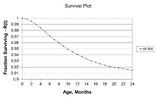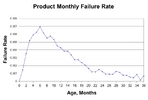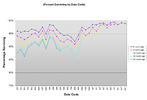I am the Quality Manager for a Tier 1 supplier to GM. Last August GM updated there CSRs to include a requirement for CQI-14 Automotive Warranty Management. Due to the new and somewhat robust requirement we've opted to define warranty management as its own process. What are some process measures for warranty? Currently we are using IPTV (Incidents per thousand vehicles) but we are unsure how best to calculate this measure. Should the incidents count toward the vehicle built the month the incident was reported, or toward the month the component itself was built? (We are considering vehicles built based on the pieces we sell in a given month).
There are issues with both methods.
Calculating each incident based on month of occurrence means that we will have spikes in weaker sales periods.
Calculating each incident based on the month the component was built means that past months will take a minimum of 18 months to stabilize.
There are issues with both methods.
Calculating each incident based on month of occurrence means that we will have spikes in weaker sales periods.
Calculating each incident based on the month the component was built means that past months will take a minimum of 18 months to stabilize.



